
Seeing as you are considering replacing your missing tooth with an implant, there is a good chance that you have asked yourself: “Just what in the world is involved with this whole dental implant process? Well, you are not alone. A lot of people are intimidated by the word “implant” — it sounds complicated and maybe even a little scary. But that is not how it actually goes: The process is simple enough, well-organised and executed over a series of steps to ensure everything happens without a hitch. If you are one of those who are searching for the Best Dental Implant Treatment, then visit Karnavati Dental Clinic.
Let’s break down what actually happens with a dental implant in clear, simple terms.
Everything begins with a consultation. You go to your dentist or another local professional who specialises in implants, and they take a look at your mouth, teeth and gums. They will also examine your jawbone with X-rays, CT scans or other imaging tests. Why? The implant does require something to hold on to, and that something is your jawbone.
You’ll also get to ask any questions you may have. Think of it as a mapping of the journey. The dentist explains if you are a suitable candidate, the time that the dental implant will take and what kind of results to expect. If your bone is too thin or weak, they might recommend a bone graft before proceeding.
If the damaged or decayed tooth is still in place, it will be removed. Not to worry: Tooth pulling is a general procedure. Your dentist will ensure you are numb and comfortable throughout the process. Once the tooth is out, some patients can proceed directly to the implant step, while others may need a brief period to heal.
It is not necessary for everyone, but if your jawbone is not strong enough, your dentist may suggest a bone graft. It's bigger than it sounds. A bone graft is really just meant to add more meat on bones or even rebuild the bone in order for a dental implant to have a robust base to sit in; based on that, recovery may last for anywhere from a couple of weeks up to some months before proceeding.
Consider this as reinforcing a wall before you hang something heavy there.
And now we reach the most crucial step of the dental implant process – having them fitted. Your dentist installs a small titanium post into your jawbone. This post serves as the root of your new tooth. Sounds intense? It's actually perfectly tolerable, as a local anaesthetic is used, and this keeps you pain-free during treatment.
The reason the implant isn’t a tooth is that it doesn’t just automatically become one once it’s in. It has to be given long enough to bond with bone, or osseointegrate. This step adds a couple of months to the process, but it is what makes implants and the teeth screwed in place on them so strong and long-lasting.
Your dentist might give you a temporary crown while the implant is bonding with your jaw, so you don’t have to walk around with a gap in your smile. This healing time is necessary, as it permits your implant to become well-fixed. In the meantime, you should follow any advice from your dentist on eating softer foods and the best way to keep the area clean.
When the implant has fully healed, the dentist connects a small connector known as an abutment. They are placed above an implant and hold your new crown! Occasionally, the abutment can be placed at the same time as the implant, but most often it is not connected to your implant until your bone has fully healed.
This is the moment you've been waiting for: crown placement. Your dentist will provide a dental impression of your teeth to ensure that the crown fits naturally and is as close in shape and colour as possible to your existing teeth. Once the crown is complete, it’s fixed on top of the abutment and bam! Now you have a brand new tooth and it looks and feels just like a real one.
The steps for the Dental Implant Procedure don’t stop when you have crowns on your teeth. You’ll need to go in for some follow-up visits to make sure everything is healing smoothly and your implant is as robust as it ever was. Daily brushing, flossing and cleanings by a professional are still crucial because your gums and the teeth beside the implant are vital parts of keeping an implant healthy.
So, there you have it. The process of a dental implant is not as horrifying as it sounds, once you break each step down. From the initial consultation to your crown looking, feeling and functioning like a natural tooth holds only the scheduled wait period of three months.
If you’re thinking of doing it, the best thing to do would be to visit the best dentist at Karnavati Dental Clinic. They will provide you with detailed answers to your questions and help you figure out the right plan for your smile.